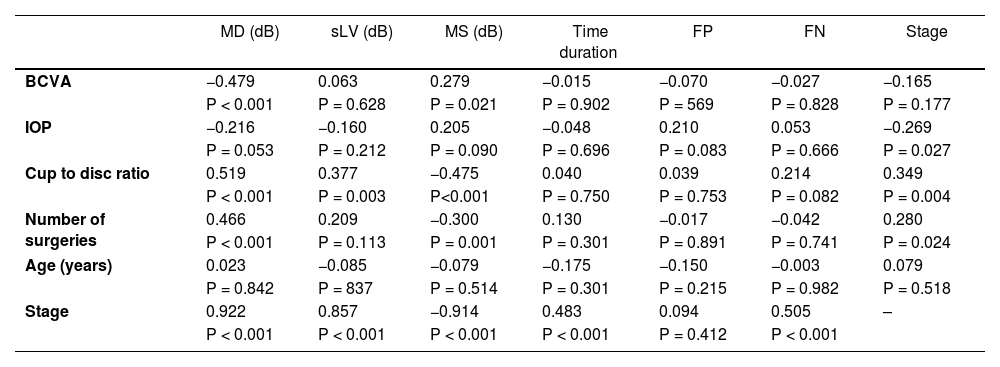To detect and characterise visual field (VF) defects using static Octopus perimetry in patients with primary congenital glaucoma (PCG) and to determine VF quality and time duration.
Material and methodsEighty-eight eyes of 70 patients diagnosed with PCG were included. Assessments were performed using an Octopus 900 and each eye was assessed with the tendency-oriented perimetry (G-TOP) algorithm. Quantitative VF data were collected: quality data (false positive and negative response, and time duration) and results of mean deviation (MD) and square root of loss variance (sLV). Qualitative data were collected: the presence of diffuse and localized defects, the affected hemifield and grade of defects using the Aulhorn and Karmeyer classification. Correlations between perimetric results and clinical variables were analysed.
ResultsMedian age was 11 (8–17) years. 65.9% (58/88) of PCG eyes showed VF defects. Diffuse defects were observed in 10/58 eyes (16.94%) (mean MD = 23.92 [SD: 2.52]) dB) and localized defects in 48/58 eyes (82.75%). The most frequent defect was spot-like/stroke-like/incipient paracentral scotoma (n = 15), nasal step (n = 8), adding arcuate defect (n = 2), half ring-shaped (n = 13) and concentric defect with a central island (n = 9). And the most frequent affected visual hemifield was inferior hemifield. Mean test duration was 2 min 12 s (SD: 21.6 s). MD and sLV values were correlated with best corrected visual acuity (BCVA), cup to disc ratio and number of antiglaucoma surgeries (all P < .001).
ConclusionA high number of diffuse and localized defects were identified using Octopus perimetry in PCG patients. The most frequent defect was paracentral scotoma and inferior hemifield was the most affected.
Detectar y caracterizar los defectos del campo visual (CV) mediante perimetría Octopus en pacientes con glaucoma congénito primario (GCP) y determinar la calidad y duración del CV.
Material y métodosSe incluyeron 88 ojos de 70 pacientes diagnosticados de GCP. Las evaluaciones se realizaron con un Octopus 900 y cada ojo se evaluó con el algoritmo de perimetría orientada por tendencias (G-TOP). Se recogieron datos cuantitativos de CV: datos de calidad (respuestas falsa positiva y negativa, y duración del tiempo) y resultados de desviación media (DM) y raíz cuadrada de la varianza de pérdida (sLV). También se recogieron datos cualitativos: presencia de defectos difusos y localizados, hemicampo afectado y grado de defectos utilizando la clasificación de Aulhorn y Karmeyer. Se analizaron las correlaciones entre los resultados perimétricos y las variables clínicas.
ResultadosLa mediana de edad fue de 11 (8-17) años. El 65,9% (58/88) de los ojos con GCP presentaban defectos de CV. Se observaron defectos difusos en 10/58 ojos (16,94%) (DM media = 23,92 [DE: 2,52]) dB) y defectos localizados en 48/58 ojos (82,75%). El defecto más frecuente fue el escotoma incipiente paracentral (n = 15), el escalón nasal (n = 8), el defecto arciforme añadido (n = 2), el semianular (n = 13) y el defecto concéntrico con isla central (n = 9). El hemicampo visual afectado con mayor frecuencia fue el inferior. La duración media de la prueba fue de 2 min 12 s (DE: 21,6 s). Los valores MD y sLV se correlacionaron con la agudeza visual mejor corregida, la relación excavación/disco y el número de cirugías de glaucoma (todas p < 0,001).
ConclusiónSe identificó un alto número de defectos difusos y localizados utilizando la perimetría Octopus en pacientes con GCP. El defecto más frecuente fue el escotoma paracentral, y el hemicampo inferior fue el más afectado.











